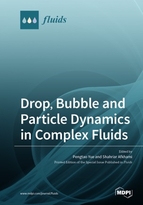Drop, Bubble and Particle Dynamics in Complex Fluids
A special issue of Fluids (ISSN 2311-5521).
Deadline for manuscript submissions: closed (15 September 2019) | Viewed by 27724
Special Issue Editors
Interests: complex fluids; interfacial flows; particulate flows; dynamic wetting; phase-field method; arbitrary Lagrange-Eulerian method
Special Issue Information
Dear Colleagues,
The presence of drops, bubbles, and particles affects the behavior and response of complex multiphase fluids. In many applications, these complex fluids have more than one non-Newtonian component, e.g., polymer melts, liquid crystals, and blood plasma. In fact, most fluids exhibit non-Newtonian behaviors, such as yield stress, viscoelastity, viscoplasticity, shear thinning, or shear thickening, under certain flow conditions. Even in the complex fluids composed of Newtonian components, the coupling between different components and the evolution of internal boundaries often lead to complex rheology. Thus the dynamics of drops, bubbles, and particles in both Newtonian fluids and non-Newtonian fluids are crucial to the understanding of the macroscopic behavior of complex fluids.
This Special Issue aims to gather a wide variety of papers that focus on drop, bubble and particle dynamics in complex fluids. Potential topics include but are not limited to drop deformation, rising drops, pair-wise drop interactions, drop migration in channel flows, and the interaction of particles with flow systems, such as pastes and slurries, glasses, suspensions, and emulsions. We emphasize on numerical simulations, but we also welcome experimental and theoretical contributions.
Prof. Pengtao YueProf. Shahriar Afkhami
Guest Editors
Manuscript Submission Information
Manuscripts should be submitted online at www.mdpi.com by registering and logging in to this website. Once you are registered, click here to go to the submission form. Manuscripts can be submitted until the deadline. All submissions that pass pre-check are peer-reviewed. Accepted papers will be published continuously in the journal (as soon as accepted) and will be listed together on the special issue website. Research articles, review articles as well as short communications are invited. For planned papers, a title and short abstract (about 100 words) can be sent to the Editorial Office for announcement on this website.
Submitted manuscripts should not have been published previously, nor be under consideration for publication elsewhere (except conference proceedings papers). All manuscripts are thoroughly refereed through a single-blind peer-review process. A guide for authors and other relevant information for submission of manuscripts is available on the Instructions for Authors page. Fluids is an international peer-reviewed open access monthly journal published by MDPI.
Please visit the Instructions for Authors page before submitting a manuscript. The Article Processing Charge (APC) for publication in this open access journal is 1800 CHF (Swiss Francs). Submitted papers should be well formatted and use good English. Authors may use MDPI's English editing service prior to publication or during author revisions.
Keywords
- drop dynamics
- bubble dynamics
- particle dynamics
- complex fluids
- non-Newtonian fluids
- Newtonian fluids
- viscoelasticity
- shear thinning or thickening
- emulsions







